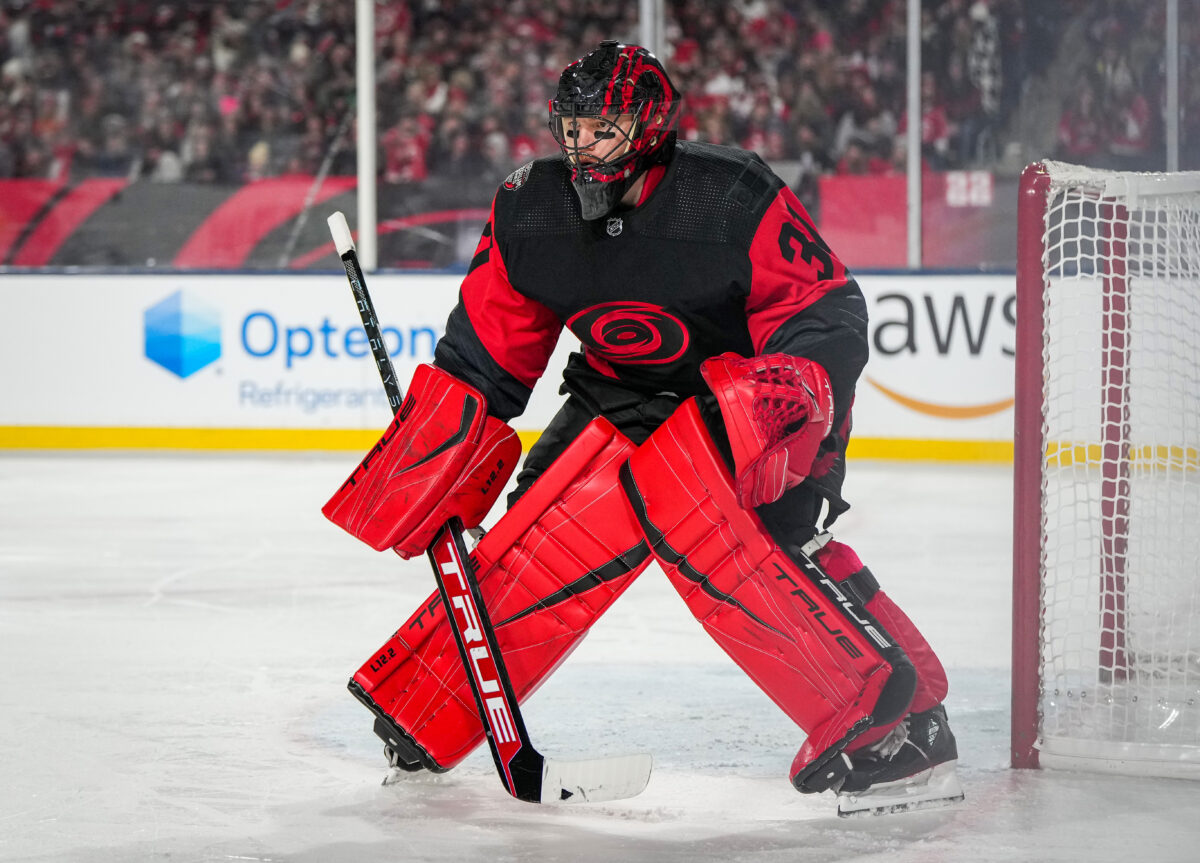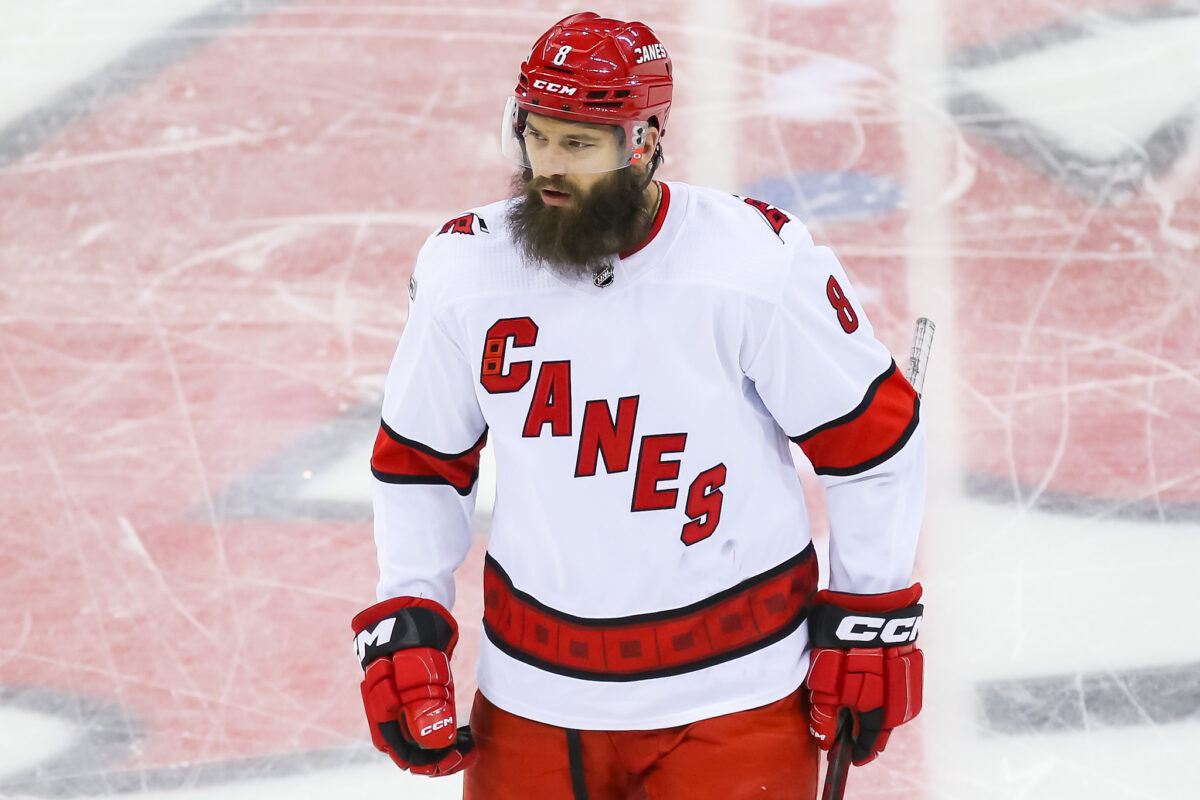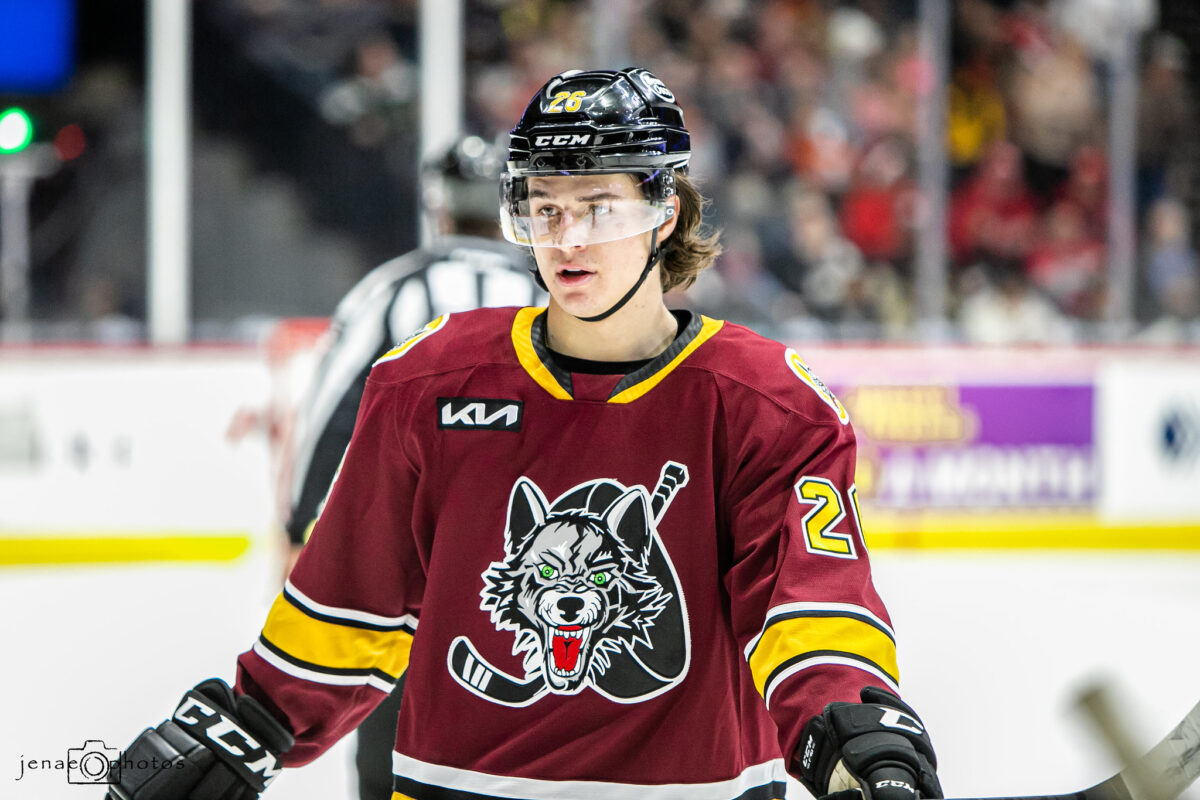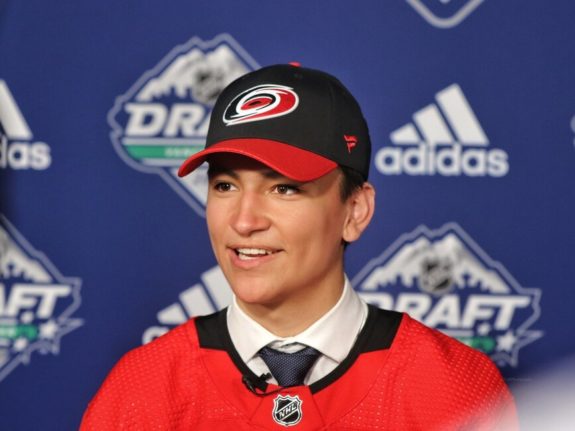For a team that has already clinched a playoff spot and sits in first place in their division, it’s been a tough stretch run for the Carolina Hurricanes. Once – and not that long ago – thought of as one of the top choices to push for a deep run in the 2023 Playoffs, a tumultuous month of March has seen them struggle through a difficult stretch of their schedule. Some familiar flaws have begun to show up in their losses to other contending teams, and the loss of Andrei Svechnikov has left the offense sputtering and head coach Rod Brind’Amour scrambling to try to figure out a lineup that can compete. Losing Max Pacioretty in January was tough enough, but being without Svechnikov has really thrown the forward group into flux.
It hasn’t been the smoothest of transitions to life without one of their most important pieces, but there have been signs of life. A big, 3-2 road win over the New York Rangers is perhaps the most obvious sign of this. However, if the Hurricanes are going to prove their many doubters wrong and make a run without two of their best offensive players, some questions will have to be answered between now and the mid-April start of the postseason. Today, we’ll discuss three of the biggest questions, and why their answers may prove to be the difference between another early exit or the exorcising of demons en route to a deep run.
Can Andersen (Or Someone Else) Step Up His Play?
To kick things off, we’ll discuss a familiar topic when considering the Hurricanes’ postseason prospects. Looking back at the 2022 Playoffs, one of the bigger questions surrounding the team was whether or not the goaltending could hold up without Frederik Andersen. While the Rangers ultimately won the battle thanks to superb play from Igor Shesterkin, it’s hard to argue that fill-in starter Antti Raanta deserved to shoulder any of the blame for the Hurricanes losing the series. He played very well and gave his team a chance to win every game.
Fast forward to this season, the question is the same, but different. Andersen always has a cloud of unpredictability hanging over his head due to his injury history. The same goes for Raanta, for that matter, who hasn’t played since March 8. Plus, even when healthy, none of the Hurricanes’ goaltenders have been particularly good. In 2021-22, Andersen finished with the second-best goals saved above expected (GSAx) in the entire league, behind only Shesterkin. This year Andersen has fallen all the way to 60th with a mark of 0.47, which essentially means he’s stopped the shots he’s supposed to, but less than one save more than that.

Meanwhile, Pyotr Kochetkov actually has the best GSAx amongst the Hurricanes goaltenders at 8.11, good for 22nd in the league. However, he has struggled ever since returning from a late-December injury, going 1-5-1 with a paltry .867 save percentage (SV%) in his seven appearances. This followed a stellar .928 SV% in November and December, a stretch that had many wondering if he was going to steal the starting goaltender spot. He’s shown he’s not quite ready for that just yet, though, and the Hurricanes probably don’t want to have to rely on him in a playoff series at the moment.
Looking at the Hurricanes’ record, on paper, it almost seems like league-average goaltending ought to be enough. The problem is, average goaltending is probably not going to get the job done for the team as currently constructed. This was always a defense-first team light on offense, and one not really built to withstand losing multiple pieces that can put the puck in the net. Their three defensive pairings have all been pretty great (per usual), but the offenses the Hurricanes will be facing in the first round alone (either the Rangers or Pittsburgh Penguins look the likeliest as of now, depending on if Carolina or the New Jersey Devils win the Metro) are going to score goals. At some point the team will need a big save or two from its goaltender. On many occasions this season, that save hasn’t come.
On the bright side, Andersen looked great in the Hurricanes’ recent home-and-home split with the Rangers. He seemed as dialed in as he has all year, making a multitude of key saves in big spots against a high-powered offense. He was particularly good on a long 5-on-3, where he looked as quick as he has at any point this year. This recent stretch shows that the 33-year-old netminder still has that elite-level play in him. The Hurricanes are going to need that to consistently show up once the Eastern Conference quarterfinals begin.
Can the Defense Continue Carrying a Big Offensive Load?
If you were to poll people around the league on what comes to mind first when thinking about the Hurricanes, surely the answer would be elite defense. Perhaps this would be closely followed by forechecking and high pace, but if defense is not the initial answer, surely it would be in the top two or three choices.
This year has been no different, as the Hurricanes have continued to display an aggressive defensive scheme that suffocates opposing forwards and keeps shots to the outside. Obviously the big question with the team isn’t about the suppression of scoring, but rather their own scoring prowess. They’ve lost quite a few games (especially against top teams) due to their inability to finish, often despite significantly outplaying their opposition. Brind’Amour has his work cut out for him trying to configure a lineup with a little more punch.

However, on the positive side, the blue line as a whole has stepped up in a huge way. Brady Skjei is having a truly remarkable year, blowing past last year’s career-high mark of nine goals with 15 in 2022-23. On the top pairing, the ageless Brent Burns has been as-advertised, scoring 12 times, setting a team record for defensemen with 53 points (with 11 games remaining to add to it), and joining Jaccob Slavin to form a simply phenomenal duo.
Going down the list, Shayne Gostisbehere hasn’t put up a ton of points since his initial few games after his trade deadline acquisition, but is nonetheless a dynamic presence that has made plays consistently and will continue to help the team generate offense. Meanwhile, his partner, Jalen Chatfield, has stepped up with six goals in his first full NHL season. That pairing has been a real luxury for Brind’Amour, one that can be deployed in any situation. That isn’t a luxury many teams have on their third pairing.
Related: Hurricanes Who Must Step Up to Replace Svechnikov
Not only do the Hurricanes allow the fewest shots (they actually lead the league in all three of low, medium, and high-danger shots against) and scoring chances in the league thanks to that elite blue line, but they also lead the NHL in goals scored by defensemen at 47. With the laundry list of forwards on scoring slumps, the defense has played a huge offensive role in a majority of their recent wins.
Perhaps there’s a chance that the aforementioned line shuffling strikes gold within the forward lines, but the Hurricanes’ offense right now is thin. There are only two healthy players that have scored at a rate in-line with expectations from a top-six forward this season, those being Sebastian Aho and Martin Necas. With struggles from players like Seth Jarvis, suffering through a sophomore slump, or Teuvo Teravainen, who hasn’t been able to find his A-game on a consistent basis after missing time to injury early on, the personnel just isn’t there anymore for a high-flying offense. The blue line must continue putting up points if they want to keep up with their Eastern Conference counterparts in the playoffs.
Is There Any Help a Quick Call Away in Chicago?
Sticking with the theme of an occasionally-painful inability to finish, could there perhaps be help worth seeking out from the minor league ranks? To this point, only Jack Drury has seen time at the NHL level amongst the prospects, but with a scuffling offense and a clear need in some important areas (mostly the power play), some new faces could potentially get a chance to make an impact before the season ends. While I don’t think any of the potential call-ups will necessarily make a huge impact on the scoresheet, two players come to mind who bring qualities that could make the team better – assuming they are able to make a quick and smooth transition to the NHL.

The first, and the one that in many ways makes the most sense, is Jamieson Rees. The 2019 second-round pick has always been known as an absolute pest that plays much bigger than his modest size, and the Hurricanes are a team that could use a little bit of jam after losing their biggest irritant. Svechnikov was their only true thorn-in-the-side type of player that would often cause a ruckus with the other team, and Rees would certainly replace some of that. He hits everything that moves, he’s willing to drop the gloves (which the team saw in preseason), and his offensive game has taken a nice step in the American Hockey League (AHL) this season.
Rees currently sits second on the Chicago Wolves in points with 13 goals and 38 points in 53 games, to go along with 84 penalties. Once upon a time, he looked like a player with legitimate top-six potential, and while that doesn’t seem as likely anymore, his physicality and playmaking could provide a spark to a forward group that could use some energy. He’s a versatile player that could realistically move around and fill a number of roles in the lineup, and his playing style should fit in quickly with the Hurricanes’ up-tempo, forechecking style. He seems like a decent bet to bring a real shot of energy to a team that has had spells of lethargy late in the season.
The other potential option – and one that may be a touch surprising – is the Hurricanes’ first-rounder from that same draft, Ryan Suzuki. It’s been a tough couple of years for the slick playmaker, but now that he’s finally had a small bit of health (although he’s still missed 22 games in 2022-23), he’s starting to show the abilities that once made him a top prospect. He’s slowly but surely developed his two-way game as a pro, showing signs of the hard-nosed play needed to fit in with the Hurricanes’ style, and he’s produced offense at a solid rate this season with nine goals and 24 points in 38 games.
The improved balance to his game is what makes him an option, but if he were the one to get some NHL action it would likely be because of his offensive ceiling. He would potentially be able to slot in on the power play, which continues to be a huge area of concern for the Hurricanes as the postseason draws ever nearer. Rees seems like the more NHL-ready of the two, in no small part because he’s played a lot more professional hockey than Suzuki has, but if the Hurricanes want to get a player that may contribute a little more offense or play higher in the lineup, Suzuki might be the guy.

There are some other options including Malte Stromwall, the 28-year-old free agent signing from Sweden who leads the Wolves in points, or Vasili Ponomarev, another former second-round pick who has played well in the AHL while showcasing a solid two-way game, but Rees and Suzuki seem like the most obvious candidates for now – if they decide to call anyone up at all. The Hurricanes still have 13 capable forwards at the NHL level, with a solid player in Paul Stastny recently sitting out a string of games. Nonetheless, a late-season callup does have the potential to provide a little bit of a lift. Things can get stale at the end of a long season, so some youthful energy might not be the worst thing in the world.
Hurricanes Must Continue to Adapt
Ultimately, and this probably doesn’t need to be said, none of those call-up options should be expected to replace Svechnikov or be impact players right off the bat, but it could be worth looking at to see if they can at least add a little scoring punch. The depth contributions that were so imperative early in the season have dried up, a problem that exacerbates the impact of the two injured snipers. They may not even want to throw in a young player for his first taste of NHL action at this stage of the season in a super-tight divisional race, but it’s at least nice to have a couple of legitimate options at the ready if needed. Plus, who knows – if another injury or two happens, they would likely be forced to call up one of these players, so it may not be the worst thing in the world to know exactly what they have.
All the Hurricanes can do is figure out how to move forward without their star power forward. They need the contributions they’re getting from the blue line to continue, and their path to the Stanley Cup is going to hinge on Andersen playing to his full capability. Teams need to catch a few breaks to make a deep run, and the Hurricanes are already behind the eight-ball in that regard. Their margin for error in the postseason has definitely shrunk after losing Svechnikov and Pacioretty. They’ll have to bring their very best brand of defensive hockey, and a couple of guys that no one sees coming are going to have to get hot. But that’s what makes it just like any other postseason: whoever gets hot at the right time usually has a great chance at making a run, and the talent is there on this roster for that still to be the case.
The Hurricanes took a gut punch, but adversity makes a team stronger. This is still an excellent hockey team, and the blueprint is there for a deep run all the same. If they can check off the first two boxes mentioned above, and perhaps get a little jolt from a prospect champing at the bit for a chance to break through and make an impact, there’s no reason to think Brind’Amour won’t have this group primed for a run.